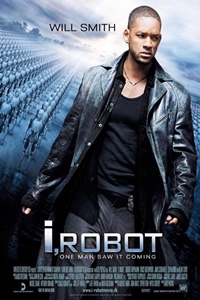I, Robot (PG-13) ★★½
 Although the futuristic I, Robot is a technically masterful film with an intriguing storyline, it lacks depth; we are never moved to the extent that we expect to be.
Although the futuristic I, Robot is a technically masterful film with an intriguing storyline, it lacks depth; we are never moved to the extent that we expect to be.
Story
The year is 2035 and Del Spooner (Will Smith) is a Chicago homicide detective investigating the apparent suicide of revered scientist Dr. Alfred Lanning (James Cromwell), the ''father'' of robotics technology. While all the evidence concludes Lansing threw himself out of a high-rise window, a vague holographic message he left behind specifically for Spooner indicates foul play. Spooner suspects one of Lanning’s robots, Sonny (voiced by Alan Tudyk), is somehow involved, but he’s not sure how. Robots, now completely integrated into society, have never committed a crime. Created by the powerful corporation U.S. Robotics, robots are governed by The Three laws of Robotics, which state that 1) A robot may not injure a human being or, through inaction, allow a human to come to harm, 2) A robot must obey orders given it by human beings, except where such orders would conflict with the First Law, and 3) A robot must protect its own existence as long as such protection does not conflict with the First or Second Law. With the help of psychologist Dr. Susan Calvin (Bridget Moynahan), whose job it is to make the robots appear more human, Spooner begins to unravel the mystery behind Lanning’s death. The key lies in Sonny--a unique robot much more advanced than the commonplace NS-5 models. In what Lanning described as his ghosts in the machine theory, Sonny is able to evolve much like a human--and is even capable of dreaming. Why would Lanning create one robot that can circumvent the laws of robotics and become a potential menace to society?
Acting
There is a reason why Lanning chose to give his holographic suicide note to Spooner--the detective is already biased against the technology. Through Spooner’s recurring dreams, we discover what his beef is with these seemingly perfect robots, and Smith doesn’t waste the opportunity to craft a character who is bitter and suspicious. Perpetually bleeding from one open head wound or another, Smith scowls a lot and delivers one-liners with blunt impact. He is less convincing in the film’s more sentimental moments, including a scene in which he tells Calvin how he lost his left arm, which has been replaced with a robotic one. His eyes well up with tears but his character’s sadness doesn’t come across convincingly. Moynahan, however, succeeds in portraying her character’s emotion. Calvin has a tough as nails exterior, to the point where you might suspect she is a covert, super-evolved robot. And her speech is about as expressive as an encyclopedia. But when Calvin looks at old photos of her mentor Lanning, Moynahan’s expressions effectively convey her grief. Perhaps the key is that Moynahan is trying not to be sad, as opposed to Smith, who seems to be forcing those crocodile tears.
Direction
Director Alex Proyas is no stranger to the sci-fi genre; after all, he helmed the edgy comic book actioner The Crow in 1994 and Dark City in 1998. I, Robot’s ultramodern Chicago looks fantastic, with its soaring glass skyscrapers and futuristic transit system with self-piloting cars that move sideways. (Moviegoers might not even notice it is actually Vancouver’s historical district of Gastown.) But what’s more impressive than Proyas’ stylized production design is production designer Patrick Tatopoulos' robots, specifically Sonny, whose face is especially intriguing to look at. While he is a hardwired robot, his mechanical structure resembles bone structure, making the robots features look very human. The soft emulsion that makes up the ''skin'' has a soft, transparency quality to it and his crystal-blue eyes appear to have depth. But despite Sonny’s personification, there is an overall disconnect with the robot. The problem, however, stems from the way Sonny was written rather than rendered. The film’s 10-year-old spec script by Jeff Vintar, titled Hardwired--a sci-fi murder mystery revolving around a robot--was merged with elements of Isaac Asimov’s I, Robot after the studio acquired the right to the film years later. Scribe Akiva Goldsman re-envisioning seems to have lost Asimov’s tender touch. Even before we know whether Sonny is guilty or not, we root for him because he comes across as naïve, but the emotional connection is never there. In fact, one of the film’s most touching moments has nothing to do with Sonny but with an abandoned warehouse full of obsolete robots crowded together in a human-like way.
Bottom Line
Although I, Robot is visually masterful and at times moving, it lacks emotion and depth because the connection between its characters, both human and robotic, is never fully explored.
To get the full Quicklook Films experience, uncheck "Enable on this Site" from Adblock Plus
box office top 10

Civil War Released: April 12, 2024 Cast: Kirsten Dunst, Wagner Moura 25.7M

Godzilla x Kong: The New Empire Released: March 29, 2024 Cast: Rebecca Hall, Brian Tyree Henry 15.5M

Ghostbusters: Frozen Empire Released: March 22, 2024 Cast: Paul Rudd, Carrie Coon 5.8M

Kung Fu Panda 4 Released: March 8, 2024 Cast: Jack Black, Viola Davis 5.5M

Dune: Part Two Released: March 1, 2024 Cast: Timothée Chalamet, Rebecca Ferguson 4.3M

Monkey Man Released: April 5, 2024 Cast: Dev Patel, Sikandar Kher 4.1M

The First Omen Released: April 5, 2024 Cast: Nell Tiger Free, Bill Nighy 3.8M

The Long Game Released: April 12, 2024 Cast: Dennis Quaid, Gillian Vigman 1.4M

Shrek 2 Released: May 19, 2004 Cast: Mike Myers, Eddie Murphy 1.4M

Sting Released: April 12, 2024 Cast: Alyla Browne, Ryan Corr 1.2M






